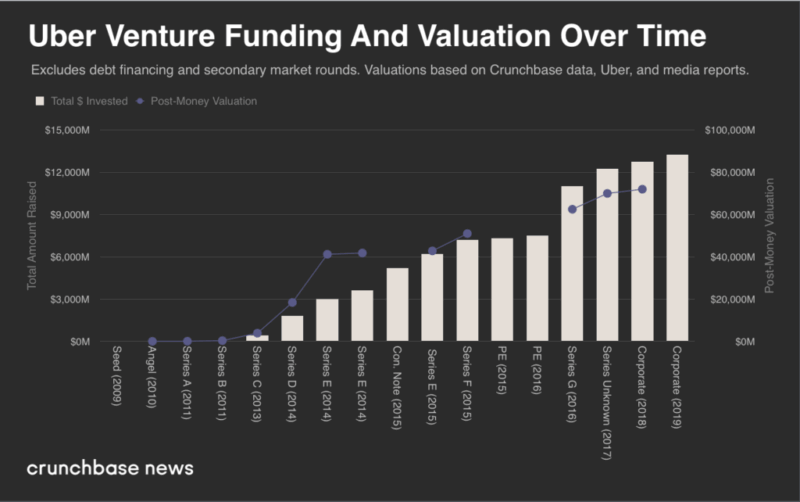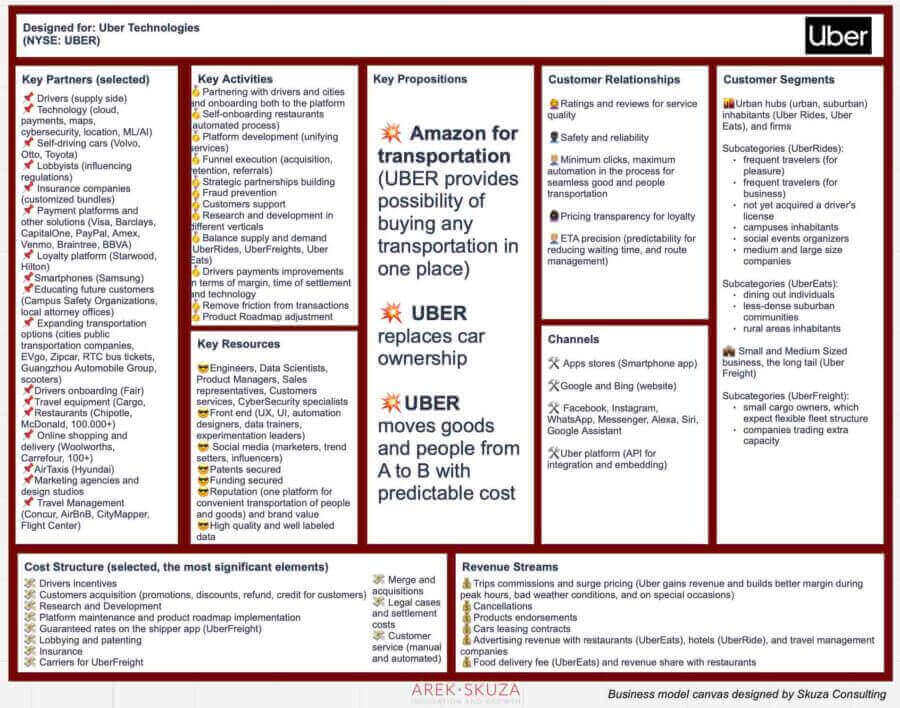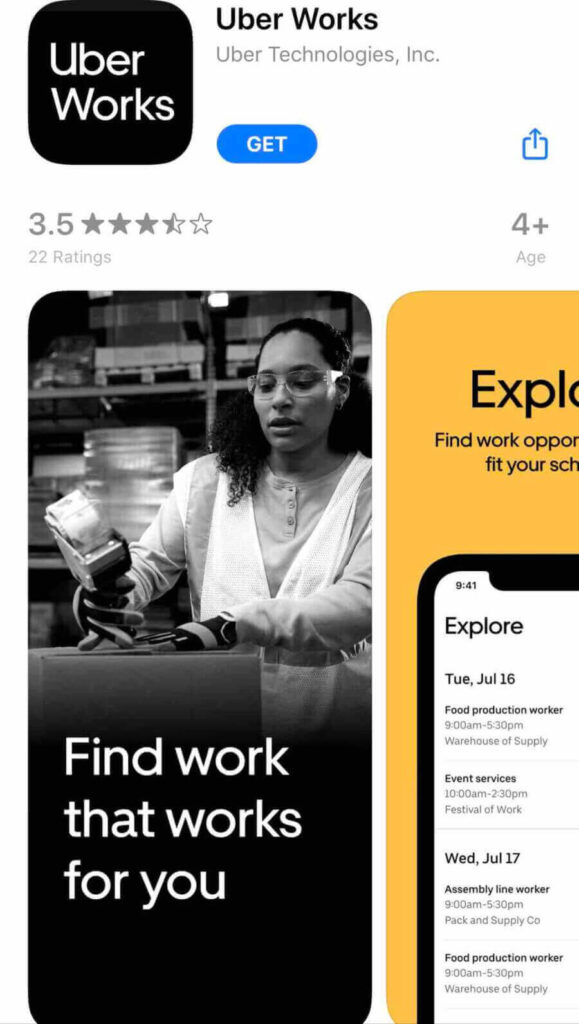Uber business model is one of the most prominent in the digital world. Investors, professors, entrepreneurs study the company moves and hope to grasp how the biggest ridesharing company brings value to customers.
There are critics too; drivers who say “They keeping milking us,” taxi companies, which don’t tolerate Uber practices or city governors, who push the break as Ubers is bringing unclear tax rules.

How does Uber business model perform?
But Uber is growing. It keeps expanding globally and adding new business lines into the company structure. Uber innovations are pressing a lot of companies to redesign their business models, restructure their margins, and come up with new products.
Revenue
Uber Technologies (NYSE: UBER) lost $1.1 billion in the last quarter of 2019 and brought $4.07 billion in revenue. It welcomes 37%, year to year, revenue growth, though. Investors like it, but they don’t like loss per share, which narrowed to $0.64 from $1.98 in the last quarter of 2018. Rides are the most significant revenue splash for Uber, and it is approximately 75% of the whole revenue mix. Besides Rides, Uber revenue comes from Uber Eats, Uber Freight, and a little bit from technology alliances.
Cost structure
Uber’s, the most massive load is the cost of revenue. The category includes insurance costs related to the Rides, incentives paid to drivers, insurance for Uber Freight, and the whole platform maintenance. Uber spent approximately 50% on this category. The company needs to deal a lot with drivers’ incentives.
Uber’s representatives claimed many times that the company business model is ridesharing based. It means that drivers are not firm employees. It raises a lot of challenges for Uber management, as drivers are expecting to be treated as employees and get benefits, not incentives only. The situation complicates during the COVID19 era.
Incentives are any amount paid to a driver that exceeds the revenue earned by that driver. In 2018 incentives jumped by $300 million, primarily due to Uber Eats. The category is expected to skyrocket in the COVID19 era.
Users acquisition
Uber spends approximately 28% on sales and marketing. In this box, we can find promotions, refunds, credits for customers, and referral bonuses. The more Uber grows, the more the category expands. Uber innovation strategy focuses on developing self-driving cars. Another expense, not a tiny one.
All of these are conducted to bring more users under Uber’s roof. Uber completes 14 million trips daily and wants to achieve a higher level of this number. In 2018 Uber announced, the company reached the level of 10 billion completed trips. It wouldn’t be possible without substantial investment in users and drivers acquisition.
According to Certify, Uber was the most expensed vendor by US business travelers in Q1 2019, accounting for 12% of the total transactions made. To put this into perspective, the second-most expensed company was Starbucks, claiming a mere 4% of the total.
If we look at that from the user’s acquisition standpoint, it turns out that businesses love Uber. Many companies integrate their expenses software to track spendings on Uber and automate the dispatching process. APIs are another great user acquisition source for the raid-hailing company.
Intense Competition
Uber doesn’t have a lot of space on the bench. Intense competition nails the Uber business model down. Uber started in two locations, New York Manhattan and San Francisco downtown. That’s where Uber tested its business models with early adopters.

Source: Taxi, Uber and Lyft usage in New York City
A study by Jonathan Hall and Alan Krueger described that 42% of UberX drivers in New York work less than 15 hours per week, while another 35% work 16–34 hours per week. Classic yellow cabs utilization rates are much higher: the TLC statistics report that the average medallion is active 29 days per month, 14 hours per day. Still, classic yellow cabs are putting a lot of pressure on UBER, not only in New York but it many cities around the world.
As I explained above, Uber business is not only ridesharing but food, transportation, and more. The list of competitors, which force Uber business model innovation is more prolonged:
- Ride-hailing companies: Lyft, Ola, Careem, Didi, Taxify, and Yandex.Taxi
- Personal mobility businesses: Motivate (owned by Lyft), Lime, Bird, and Skip
- Food delivery businesses: GrubHub, DoorDash, Deliveroo, Swiggy, Postmates, Zomato, Delivery Hero, Just Eat, Takeaway.com, and Amazon.
- Freight: C.H. Robinson, Total Quality Logistics, XPO Logistics, Convoy, Echo Global Logistics, Coyote, Transfix, DHL, and NEXT Trucking.
- Driverless vehicle firms: Alphabet’s Waymo, GM’s Cruise Automation, Tesla, Apple, Zoox, Aptiv, May Mobility, Pronto.ai, Aurora and Nuro
Uber is not living a comfortable life. The company innovation strategy needs to evolve constantly and look for new value propositions in many different industries.
Not only are competitors taking an easy shot, but the number of companies, which would prefer UBER crash down, is quite high. Uber doesn’t compete only with other startups, which also utilize innovative business models. Among competitors are global corporations with big pockets, and we all know, these folks will not sit and watch.
Uber business model canvas

Uber’s business model is continuously evolving, and it becomes more and more complicated. The ride-hailing giant stands on rides, food delivery, and freights. On one side, Uber generates revenue from so many sources that investors should be happy as the company doesn’t count on one single revenue source. On the other hand, the business model canvas shows how complicated the structure is and how hard it is to predict the future of Uber innovations.
Taxi company business model? Sort of…
Yes, you pick up the phone, press the screen a few times, and Uber driver is ready to pick you up. Like Taxi, sort of. Ubers uses the platform business model and leverages a positive network effect. As the business model canvas explains, Uber invests heavily in platform development. The company CEO wants the firm to be an Amazon of transportation. It means, in the future, we will not be interested how we will get to the destination.
When you order through Amazon, you don’t bother thinking how the book will come to you. Amazon handles this. Uber wants the same. Possible? Hm. Now we can see that Uber partners with thousands of partners to make the dream comes true.
Related article: Amazon and Artificial Intelligence
Uber innovation teams are pulling hairs to introduce smarter algorithms and hire Artificial Intelligence to automate more and more tasks. We like to think that taxis are moving people, but they can also move goods. Uber engineers wake up every day to make it a smooth and sleek experience. They need AI to configure routes quickly, spotting hot spots and checking if you will not be dropped off on the bike lane.
Do regular Taxi drivers think about it? Well, some do, but not all of them. For this reason, Uber is smarter, more scalable, and finally, Uber doesn’t want to care if you get there by bus, air taxi, or scooter. All it cares is to learn your preference by studying data, bringing transparent pricing, predict ETA and your credit card properly connected.
Uber’s oxygen are lobbyists, drivers, and cities
If you want to kill Uber, you should take over drivers, control cities and hire all the lobbyists. Uber will evaporate. CEO of Uber likes to say that the company wants to be an operating system for city life.
Hungry? Don’t worry, Uber Eats will bring the food, or Uber driver will go shopping for you. Drivers make it happen. Are you a small logistic company driver and owner. Join the freight app and start shipping your freeloading space. Uber will help you not to carry the air on your truck.
[elementor-template id=”3798″]
Your team booked the table for a business dinner, no problem, your company travel management system will send Uber automatically. Cashless and bookless experience. Almost invisible transaction.
Are you a restaurant owner, and because of COVID19, you need to start home delivering? Uber platform will fire off the self-onboarding process, and after a few days, the company drivers or bikers will start delivering your food to people.
Arteries, veins and red cells
Drivers are red cells in this business; cities are veins, which makes it possible for the cells to travel. Lobbyists help to open the arteries, so Uber can start orchestrating the ecosystem.
If you study carefully business model I have mapped, you will notice that lawsuits and settlements are part of the company cost structure. It means, Uber doesn’t avoid lawsuits, it is part of this business. Without them, Uber (lobbyists) can’t open the next countries and cities.
Uber business model innovation
Uber spent approximately 10% – 15% ($1 – $2 billion dollars) of its revenue on innovations. From self-driving cars and flying taxis (partnership with Hyundai) to sophisticated algorithms that predict prices of transportation.
We love our customers
You don’t need to criticize the driver for speeding or pushing brake to the metal. The app calls gyrometers and checks it automatically. Uber doesn’t require customers’ effort to learn, as it determines a lot automatically. If your driver was texting during the drive, either Uber finds it, or ask you the proper question and learns anyway.
Related article: Driving product growth with business model innovation
Pricing is an integral part of the company business model
Taxis pricing is regulated. That’s it. There is not much driver can do about it. Meanwhile, Uber is running proof of concept in California that allows some drivers to choose how much they will charge customers. Drivers who wish to get more per ride will have to wait longer for trips. Can you imagine this? It is almost reverse engineering innovation.
We are already pretty familiar with the surge price mechanism. It is an additional multiplier in the price estimation process that is added when there is a lot of strain in the system, a supply and demand function. When it is raining or snowing, condition changes, supply, and demand are affected. Uber revenue can be improved, so the algorithm calculates prices differently.
We will find you a job
When COVID19 hits, another force showed up and put pressure on the Uber business model. But the flexibility is in the company DNA. The firm quickly launched a WorkHub. It’s the service that helps drivers to find alternative jobs.


Partnerships with restaurants pay off here. People stay at home more, and they need more meals to be delivered. Restaurants struggle with hiring drivers. Uber innovation team quickly open the platform and released WorkHub. Now restaurants, shops, and others can contract drivers.
“Hello!, yes, we will dispatch the ambulance soon”
Remember, drivers, are the red cells. They carry people, food, essentials, and freights. Can they carry inured people? Of course. If the patient isn’t experiencing an emergency, the driver can be an excellent transportation option. Amazon for transportation happens here too.
This service can include moving patients between medical facilities, home to office, home to medical centers, and hospitals. How did it happen? Uber business model can listen to customers. Engineers quickly decode datastream. The company found out there is a significant number of trips to hospitals already via the app. Bang, we have Uber Health. Another specialized service, next to Uber Kids, Uber Elevate (drones), Uber Jump, Uber Credit Card, Uber Vouchers – the list keeps growing.
Conclusion
Since its inception, Uber developed a business model that offers a robust value proposition. The firm started with a simple but very innovative product offering and slowly went up to something more than a ridesharing company.
It’s incredible how a company can discover, test, and scale innovation globally. All sounds perfect, and only one question gives tech and business world goosebumps – will the company achieve profitability stage. We need to wait to found out.

